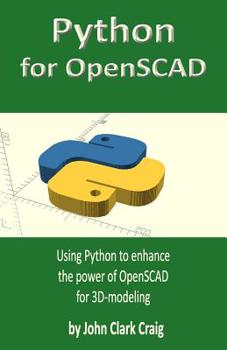Python for OpenSCAD: Using Python to enhance the power of OpenSCAD for 3D-modeling
OpenSCAD is a powerful 3D modeling language for, among other things, creating 3D printed plastic parts for hobbyists and engineers.
This book enables the reader to leverage the power, versatility, and simplicity of Python to enhance and super-charge the already powerful capabilities of OpenSCAD for Makers, Engineers, and anyone who wants to create 3D shapes for 3D printing or manufacturing.
Both Python and OpenSCAD are free software tools that run on Windows, Macs, and Linux machines. The symbiotic use of these two tools enables a much shorter learning curve than when using the expensive software packages, and it puts you in control of your designs instead of your designs controlling you
The complete source code Python listing for driving OpenSCAD using easier-to-remember and easier-to-use commands is included in this book, along with creative examples of the use of all new commands. You'll also see how easy it is to integrate these two tools such that you'll see results instantly on your screen when your Python code runs.
Table of Contents of Python for OpenSCAD
Introduction About PythonAbout OpenSCADOpenSCAD LimitationsPython to the RescueHow Python was added to OpenSCADHow to Get StartedWhere to Get PythonWhere to Get OpenSCADHow to Learn from this Book
1 - Spheres
2 - Color
3 - Boxes
4 - Cylinders
5 - Tubes
6 - Cones
7 - Triangles
8 - Animation
9 - Polygons
10 - Polyhedrons
11 - Regular polygons
12 - d104
13 - Translate and Rotate
14 - Scale
15 - Resize
16 - Rotate extrude
17 - Spiral
18 - Hull
19 - Minkowski
20 - Mirror
21 - Projection
22 - Slice
23 - Offsets
24 - Difference, Union, & Intersection
25 - Assemblies
26 - Gears
27 - Mason bees
28 - Surface
29 - Platonic solids
Appendix A. openscad.py





